Hidden hunger (also known as micronutrient malnutrition) affects most countries in Central and South Asia. In Afghanistan, the prevalence of anaemia, an indicator of iron deficiency, has ranged from 50-75%, and night blindness, an indicator of vitamin A deficiency, is more than 20%. The primary source of food energy intake in the region is wheat flour, most of which is not fortified with essential vitamins and minerals. Kazakhstan, the world’s number one exporter of milled flour, exports wheat and wheat flour to Afghanistan and other neighbours. Fortifying an important food staple like flour, as well as cooking oils, with essential micronutrients, can be a vehicle for providing adequate levels of nutrients in diets and help offset some of the micronutrient deficiencies among the local population.
GAIN has been working on food fortification programs within Central Asia for a number of years. In 2013, GAIN launched the USAID-funded Afghanistan, Pakistan and Central Asia Republics Regional Fortification Initiative, which aims to build capacity for food fortification with essential vitamins and minerals in order to improve micronutrient intakes across the region. The partners involved in the initiative include governmental bodies, private sector, and civil society partners. The key objectives of the initiative include establishing and strengthening regulations and monitoring, facilitating harmonization of regional food fortification standards, as well as strengthening quality control and enforcement.

Women preparing bread in Tajikistan. © GAIN
In order to share successes and lessons learned over the last few years, USAID and GAIN have recently worked on six videos about the different components and areas of the project.
Afghanistan
- In Afghanistan micronutrient deficiencies are widespread with 40% of women of childbearing age and 44% of children under 5 suffering from anemia.
- Food fortification is one of the most cost efficient public health tool to end micronutrient deficiencies. GAIN, USAID, and partners are facilitating trade of fortified wheat flour and contributing to improve consumer awareness about its health benefits with huge nutrition impact across the nation.
- To date, 15% of Afghanistan’s wheat flour that’s imported from Kazakhstan is fortified with vitamins and minerals.
Kazakhstan
- Wheat flour is a critical staple food in Central Asia, accounting for between 50-70 percent of caloric intake. Kazakhstan is among the top wheat flour exporting countries in the world. Neighbouring countries in the region import part of their wheat flour from Kazakhstan, which, if fortified, would have a significant impact.
- GAIN and USAID are working with key stakeholders including the Kazakh Academy of Nutrition and the Kazakh Union of Grain Processors, to raise awareness and create an enabling environment for increased production and trade of adequately fortified wheat flour in Kazakhstan and throughout the region, with an emphasis on improving fortification processes, regulations and monitoring.
- Over the years, several efforts were made to tackle down malnutrition issues. In five years, there has been a 50 percent increase in household consumption of fortified wheat (27 percent in 2011 and 40 percent in 2016).
- Kazakhstan has seen a 32 percent increase in the production of fortified flour and 60 percent of large-scale mills are now able to fortify wheat flour.
- Fortified products can be identified by this logo developed by the Kazakh Academy of Nutrition.
Pakistan
- In Pakistan, half of women and 62% of children are iron deficient. Fortifying flour is an effective way to get people the vitamins and minerals they need to live healthy and productive lives.
- It is estimated that 3 billion dollars in GDP are lost annually in productivity and health care costs due to vitamin and mineral deficiencies.
- Flour can be fortified with a premix of necessary micronutrients to make it more nutritious.
- The micronutrient premix is not available in Pakistan and importing it used to be very expensive. For this reason, GAIN worked with the government to exempt premix from tax and duty reducing the cost for millers to produce the fortified wheat flour and for the consumer to buy it.
- GAIN is also helping the industry to understand the benefits of fortification and working with them to build their capacity to produce high-quality fortified wheat flour, cooking oil and ghee.
Central Asia
- Bread is a staple food across Central Asia and the region has a robust trade in wheat flour, with millions of tons moving between countries such as Pakistan, Afghanistan and Kazakhstan.
- Fortifying this flour with essential vitamins and minerals is a cost-effective way of improving nutrition and health in Central Asia.
- GAIN has supported development of a single standard formula of a premix of vitamins and minerals that is added to flour so that people have the right levels of nutrients they need.
- Using one standardized premix formula is easier for flour producers. It also means that fortified flour can move more freely in the region.
Videos





